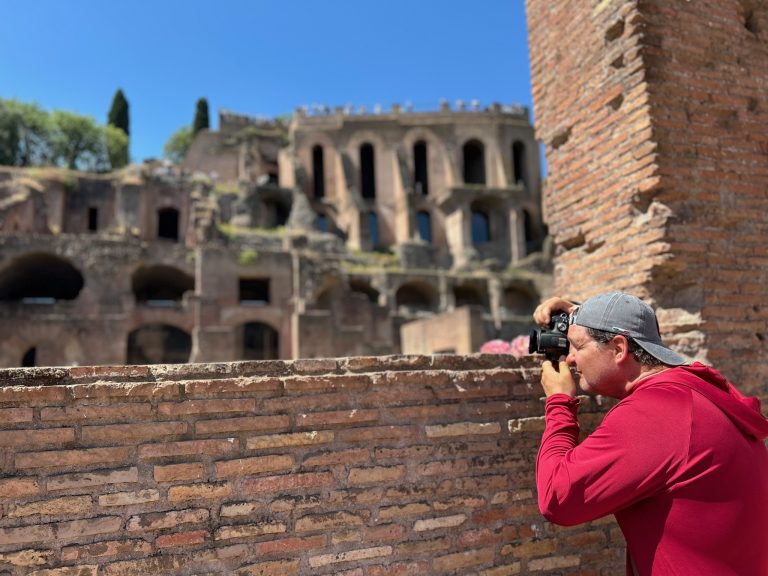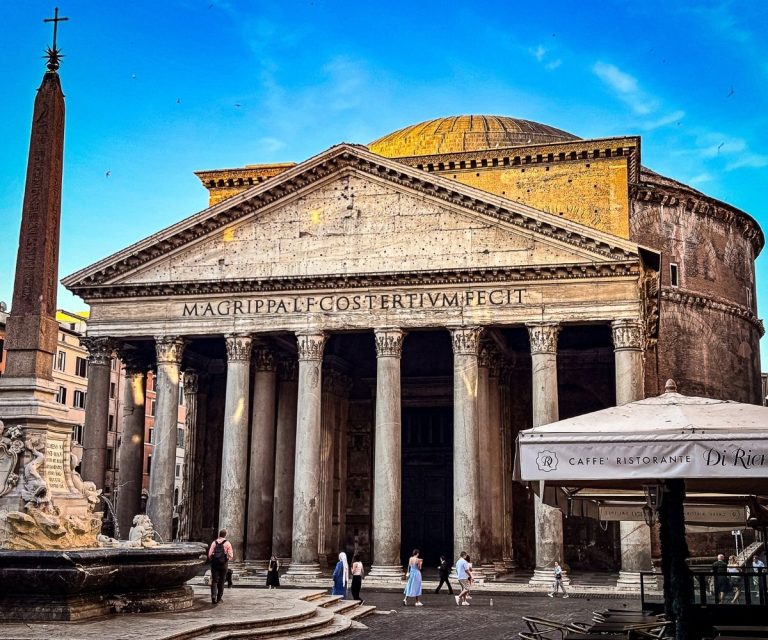15 Travel Photography Ideas That Always Work
You’ve just arrived in a new city. Your bag’s on the hotel floor, your camera’s charged, the light is perfect—and suddenly, you’re stuck. What should I shoot? It’s the question that haunts even the most seasoned travel photographers. Not because there’s nothing to photograph, but because there’s too much.
This moment—where excitement meets indecision—is where most people start snapping random buildings or whatever’s in front of them. But if you want photos that feel like your trip (and don’t just look like everyone else’s), you need a better plan.
These are the go-to shots I use every time I travel—tested, real, and reliable. Whether you’re in Rome, Dublin, or some small town off the map, these prompts will help you find your frame—and shoot with purpose.
Cafés and Outdoor Dining
Nothing says “travel” like a sidewalk café. Locals lingering over espresso. Tourists trying to decode the menu. Waiters gliding between tables like it’s a ballet. These moments are travel gold—and they’re almost always right in front of you.

But here’s the thing: most people walk right past them. Or they snap a quick, crooked photo of their cappuccino and move on. Instead, pause. Breathe. Look around. A good café photo isn’t just about what’s on the table—it’s about everything happening around it.
Frame the awnings, the café signs, the clinking glasses. Let the light and shadows play across the tables. Capture real people doing real things: reading a menu, arguing over the bill, zoning out in the sun, or just watching life go by. The more candid it feels, the better. You’re not shooting food—you’re shooting atmosphere.
And don’t forget the details. What’s hanging on the walls? What does the menu look like? Are the chairs mismatched? Is someone’s dog sitting under the table like it’s totally normal (because in Europe, it is)? These small things make the photo feel lived in.
These images don’t need captions. They are the caption. A café photo tells you everything: time of day, local style, tempo of life. Bonus points if there’s a street sign, like this one from Piazza San Michele in Lucca. It grounds your photo in a place without needing GPS—and makes the viewer feel like they’ve already pulled up a chair.
Food and Drinks
Food is memory. The kind you can taste years later—if you bothered to photograph it. That’s why one of the smartest things you can do as a travel photographer is to let your camera eat first.
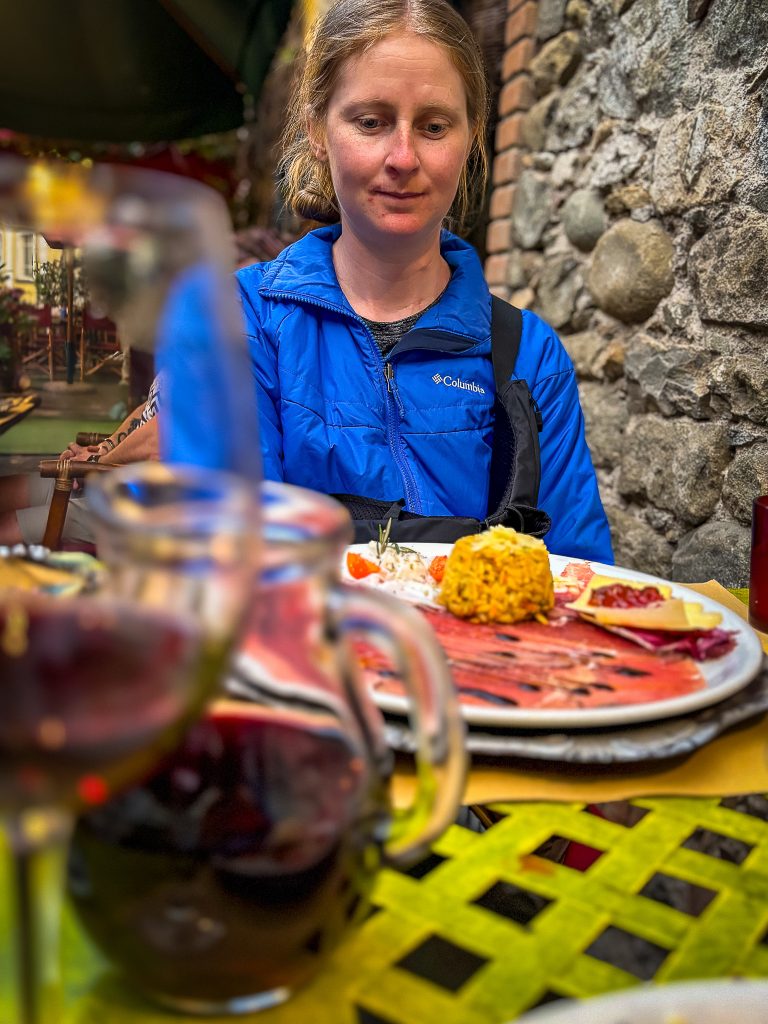
It’s not about being a food influencer. It’s about documenting the experience of a place through what’s on your table. Local dishes, mismatched plates, condensation on the wine bottle—these things tell a bigger story than a museum ever could. Plus, food is universal. Everyone understands hunger, satisfaction, and the shared ritual of a good meal.
In this shot, we were tucked into a quiet alley in northern Tuscany. Cold, a little worn out from walking, not really sure what we’d just ordered. The plate showed up like a color wheel: saffron rice, smoked meats, sprigs of rosemary, pomegranate seeds tossed in like an afterthought. A jug of house red—barely drinkable but completely right—sat between us like a centerpiece. She didn’t say much, just looked at it all. So I picked up the camera.
When you’re photographing food, don’t just shoot the plate. Shoot the moment. The glass mid-pour, the smirk before the first bite, the table setting, the lighting, the crumbs. Stand up if you have to. Lean in. Get it messy if that’s what it was. Because someday, you’ll forget the restaurant’s name—but not how it felt to be there.
Locals, Not Tourists
One of the biggest mistakes travel photographers make is filling their gallery with people who clearly don’t live there. Tourists with wide-brim hats, backpacks, and souvenir bags—they’re everywhere, and they rarely add any real sense of place. You end up with photos that could’ve been taken in a theme park.
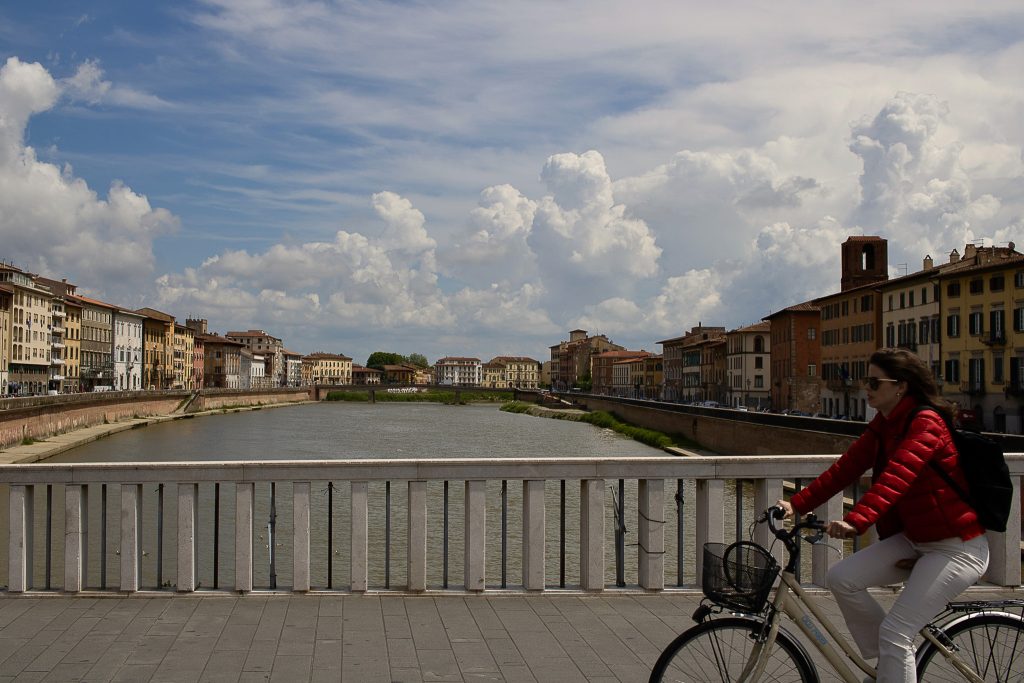
Instead, look for locals. The baker opening the shutters. The old guy sweeping his stoop. The cyclist in a red jacket, crossing a bridge like she’s done it a thousand times. These people are the rhythm of a place. They belong—and when you photograph them, your image does too.
You don’t always need to ask. Candid shots are totally fair game if you’re being respectful. But if you have time—and guts—ask your server or shopkeeper for a quick portrait. It can lead to real connection, better photos, and sometimes even an invite to something unexpected.
Pro tip: saying “You look awesome—can I take a quick photo?” works way better than “Can I photograph you?”
Color as the Subject
Sometimes, the subject isn’t a person or a building or a monument. Sometimes, it’s just the color.
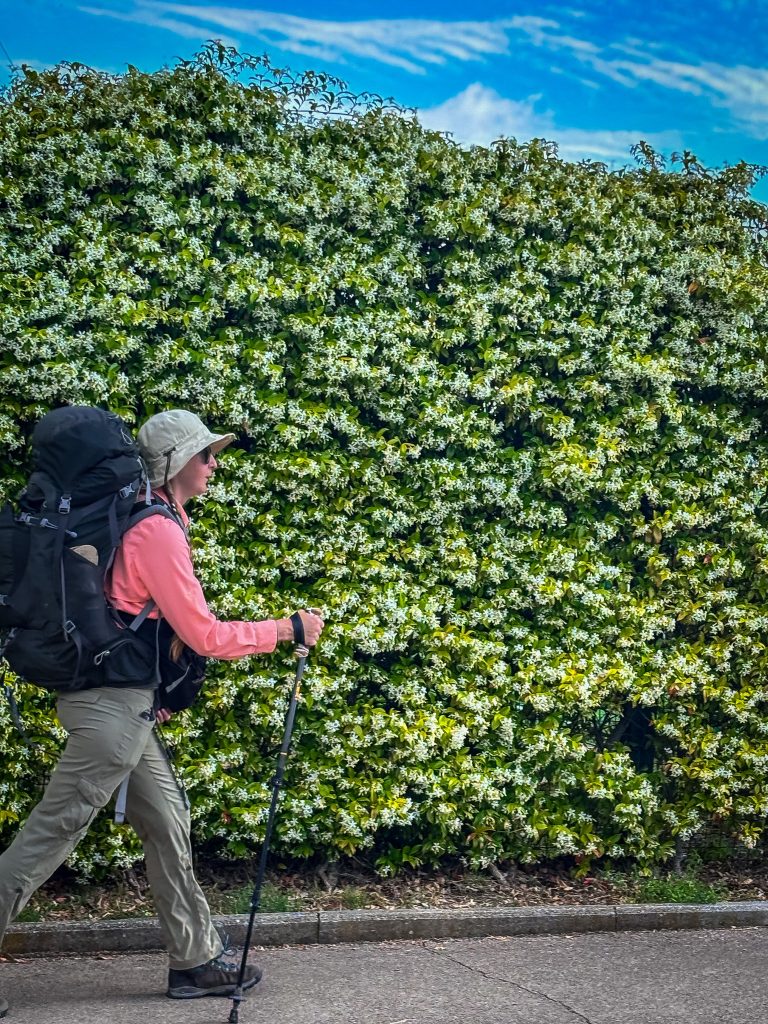
Travel photography often gets bogged down in trying to document landmarks, but don’t forget—color tells just as much of a story. It carries emotion, memory, mood. The warm reds of Rome’s rooftops. The deep turquoise of a Greek door. The saturated yellow of a Portuguese tram. These are things you feel before you even know what you’re looking at.
This image? It’s not about the walker, even though she’s clearly on a journey. It’s about the color contrast. That rich pink shirt against the mass of tiny white flowers. The soft green of her pants echoing the hedge. The pop of blue in the sky. It’s a frame you feel before you process it—and that’s the point.
When you’re shooting, start noticing these combinations: laundry lines against stucco walls, market fruit against patterned tiles, blue boats on golden sand. Color draws the eye—but if you shoot it with intention, it also draws emotion. Try to fill the frame. Get low or high to cut out distractions. Simplify the scene until it’s just the color and the feeling it gives you.
Detail Shots of Architecture
Big buildings are impressive. But the real character of a place lives in the little things—what you notice when you stop trying to take the postcard shot and start noticing the textures.
Door knockers. Window shutters. Rusty hinges. Worn staircases. Carved columns. These aren’t just decorative—they’re fingerprints of time and place. Every scuff and crack tells you something. About the people who built it. The people who use it. The centuries in between.

This photo? It’s a carved face staring out from an old wooden door. Probably Roman-inspired, definitely hand-crafted, and absolutely loaded with drama. You could walk by it a hundred times and never really see it. But now it’s burned into memory—wood grain, iron patina, and all.
The trick is to slow down. Walk through the alleys instead of the wide boulevards. Look up. Look low. Look sideways. Use your phone’s zoom or macro mode if you need to. Focus on texture, contrast, and shadow. You’re not photographing the building—you’re photographing its soul.
And when you put all these details together—door by door, window by window—they add up to something bigger than a skyline. They become the bones of the story you’re trying to tell.
Cityscapes from High Up (aka Establishing Shots)
Every good story needs an establishing shot—that wide, sweeping view that tells you where everything’s about to happen. In travel photography, it’s no different. Getting above it all lets your viewer breathe for a second. It gives context. It shows how the city or village sits inside the landscape. And honestly, it just looks damn good.

Whether it’s from a tower, a rooftop bar, a church bell tower, or the top of a hill you didn’t know you were climbing until it was too late, these shots are worth the effort. You’ll get a sense of scale, light, and layout that you can’t capture from ground level.
If you’re staying somewhere with a view (or close to one), skip asking the manager and talk to the front desk staff or concierge. They’re more likely to slip you a tip about the best staircase, terrace, or rooftop with a view. Sometimes they’ll even unlock it for you if you ask nicely.
So next time you land in a new town, look up before you start shooting. You might find your best photo before you’ve even zoomed in.
Churches, Palaces & Museums
Every travel destination has at least one: the over-the-top church, the velvet-lined palace, the dusty museum full of relics. These places can be photographic treasure troves—if you know how to work with the light (or lack of it).

Crank up your ISO. Most indoor landmarks don’t allow tripods, and you don’t want to be that person fumbling with gear while tourists flow around you like water. Embrace handheld. Stabilize with your body. Use pillars, benches, or even your own knee to keep things steady.
Look for symmetry. Lead-in lines. Light hitting marble in just the right way. Don’t just shoot the altar—shoot the reflection of a window in the floor, the pattern on the ceiling, the layers of history carved into the columns.
If you’re unsure whether photography is allowed, ask. Or check for signs. And if it’s quiet, shoot respectfully—no flash, no shutter chaos. You’re not just a photographer here—you’re a guest.
Local Architecture
Some buildings are so tied to their location, they practically shout it. The Colosseum doesn’t whisper “Rome”—it yells it across centuries. The key as a travel photographer isn’t just to capture these icons, but to do it well. That means more than just standing in front and snapping the postcard angle.

First, find your light. Even the most photographed buildings come alive again when the light hits them differently. Side light at golden hour? That’s your best friend. It adds shape, depth, and warmth to even the most over-exposed landmark.
Second, shoot buildings in context. Step back and see what surrounds them. Are there trees, scooters, laundry lines? Can you frame the building with an archway or doorway? Or catch a shadow play that adds dimension? Architecture isn’t just about structure—it’s about placement. Let the photo answer: “What’s it like to stand here?”
Iconic architecture might be the most obvious shot you’ll take—but that doesn’t mean it can’t be one of the best. With the right light and a bit of patience, it goes from cliché to cinematic.
The Hotel Room (Yes, Really)
Most people don’t think to photograph their hotel room. But here’s the thing—travel isn’t just piazzas and panoramas. It’s where you sleep. Where you drop your bag. Where you open the window and smell a new city for the first time. And ten months from now, when you’re back home and that memory feels blurry, a shot of the bed you collapsed onto can bring it all back.
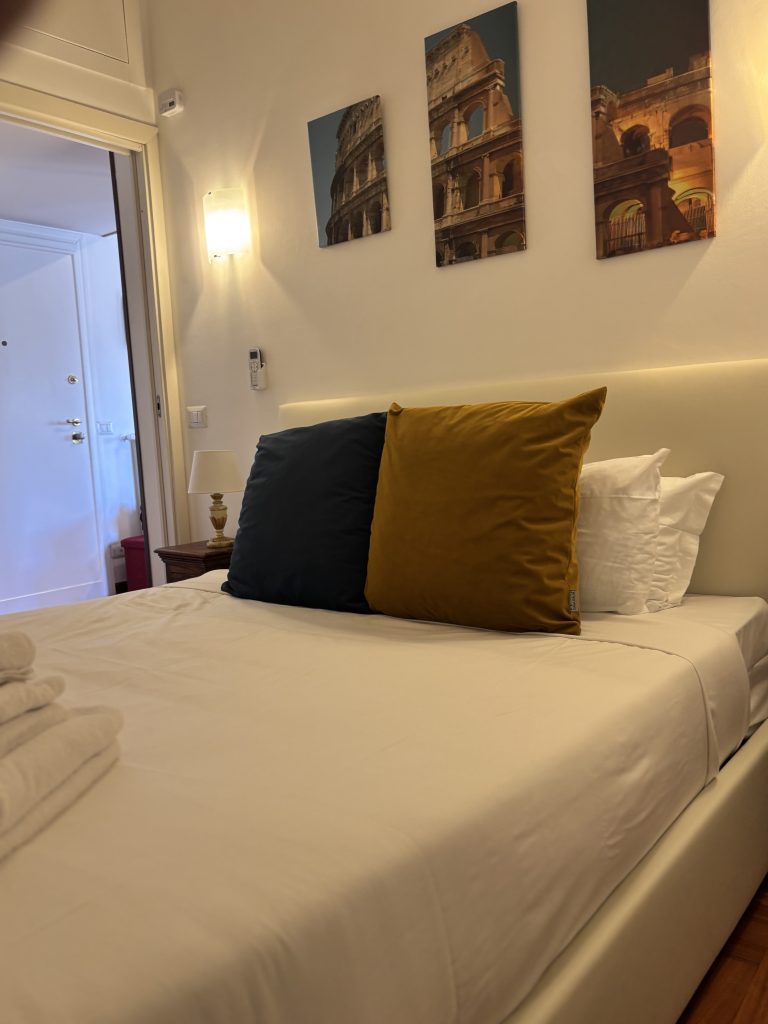
But timing is everything. Shoot it before your stuff explodes across the floor. Before the towels are used, the wrappers pile up, and your shoes end up under the desk. You want it clean, calm, and inviting—like the kind of place you’d actually recommend.
Pro tip: Get low to make the bed feel bigger. Use the widest lens or setting you’ve got. Turn on every light. Shoot toward a corner if you want depth, or straight on for symmetry. You’re not trying to sell it—you’re trying to remember it.
Lobbies Worth Sharing
You’ve probably walked through dozens of beautiful hotel lobbies without taking a single photo. Why? Because you’re tired, carrying bags, or worried it’ll feel awkward. But let’s be honest—if the hotel is proud enough to fill the space with marble floors, giant chandeliers, and oversized art installations, you should be proud enough to take the shot.

Lobbies are the first impression and often the last memory. They’re where you plan your day, ask for directions, dodge other guests, and sneak an extra croissant from the breakfast cart. Capturing that space helps tell the full story of your stay.
Most lobbies are well-lit and photogenic for a reason: they want to be noticed. So go ahead—frame the velvet couches, the tiled floors, the moody lighting behind the front desk. Look for symmetry, reflections, and soft light. And if you want to set up a tripod or take more than a quick handheld shot? Ask. The front desk staff will usually say yes—or point you to a better time to shoot it empty.
What to look for: Art deco elevators. Vintage mail slots. Grand staircases. Boutique check-in desks. Even just a quiet corner where the morning sun hits the coffee bar. These are the unexpected gems you’ll forget without a photo.
Lobbies aren’t just functional—they’re often the most stylish, curated part of a hotel. So if it catches your eye? Capture it. You’ll thank yourself later.
Local Markets and Shops
If you want your photos to actually feel like travel, skip the magnet stands and keychains. Head to the local market. It’s where the real story is told—in peppers, not postcards.

Markets are one of the fastest ways to understand a place. What people eat. What they sell. How they interact. You’ll find piles of tomatoes next to buckets of snails, old women counting coins for wild fennel, a guy who looks like he’s been slicing prosciutto since the 1940s. It’s all right there—texture, color, motion, and culture.
When you photograph these spaces, look for rhythm and repetition. Wicker baskets. Crates. Chalkboard prices. And don’t wait for it to be empty—shoot it full of life. The best market shots have a bit of blur, a little chaos, someone walking out of frame with a paper bag full of asparagus. Real life, not styled.
Look for what defines the culture: handmade pasta, hanging meats, blocks of local soap, or baskets of dried chili. These aren’t just great photos—they’re clues to how people live.
Pool and Beach Scenes
Let’s be honest—half the reason people scroll travel blogs is to imagine themselves somewhere else. Usually with their feet up and a drink nearby. That’s why pool and beach photos matter—and why timing them right makes all the difference.

The trick? Shoot early. Before the chairs are covered in wet towels. Before the pool gets that oil-slick shimmer. Before the guy in neon trunks cannonballs into your perfect reflection. These shots work best when the scene feels calm, clean, and ready for someone—anyone—to walk into it.
Look for lines and layers: the curve of the pool, the umbrellas, the mountain or sea backdrop. Get low to the water for reflections or shoot from above if you can snag a balcony view. And don’t over-edit—let the colors and light do the heavy lifting.
These aren’t just pretty pictures. They’re placeholders for escape. So shoot them clean. Shoot them honest. And give people something they can step into—if only in their minds.
Repeating Patterns
There’s something deeply satisfying about symmetry. Our brains love order—especially when it’s layered into chaos. That’s why repeating patterns are such powerful photo material. They stop people mid-scroll. They pull you in. And when done right, they give your shot instant structure.

Think windows in a row. Stacked chairs. Market stalls. Laundry lines. Or, if you’re lucky—umbrellas suspended over a narrow alley in southern Italy.
Patterns work best when they almost go too far. Fill the frame. Don’t just shoot part of the design—lean into it. Let the repetition become the subject. And then—add the twist. One red door in a line of blue. One person walking through a sea of tables. One bright umbrella that doesn’t match. That single outlier is what gives the photo life.
You don’t need a drone or a perfect angle—just train your eye to see the rhythm of everyday things. Doors. Tiles. Arches. Even shadows. Then wait for something—or someone—to disrupt it in a way that makes the viewer feel like they caught the moment with you.
Have a Magazine Assignment Mentality
Here’s the mindset shift that changes everything: pretend you’ve been hired by a travel magazine. Not to take a thousand random photos, but to come back with a tight 10-shot story that captures the soul of the place.
That means thinking like an editor before you ever touch your shutter. What’s going to make the two-page spread? What tells the story beyond “I went here”? You’ll need variety, emotion, texture, and at least one frame that punches someone in the gut (in a good way).
Try this: before your trip, write a 10-shot checklist. Not a location list—a theme list.
• A local doing something everyday
• A plate of food you’ve never seen before
• A wide shot from up high
• A weird little detail
• A window with great light
• A splash of color
• A moment of movement
• A doorway or entryway
• A quiet night scene
• A shot that only makes sense there
The goal: By the end of the trip, you’re not just dumping 2,000 images into a folder—you’re curating a visual story that says something. About place. About time. About you as the observer.
So yeah, shoot for fun. But also shoot with purpose. Think like an editor. Frame like a storyteller. And give every shot a reason to be there.
Add Life with the “Power of One”
You can have the perfect light, an interesting wall, a great location… and still end up with a photo that feels empty. That’s where the “power of one” comes in.

One person in the frame gives everything else context. It adds scale, mood, and most importantly—life. Whether they’re walking through a plaza, staring out a window, or just sitting in a room that practically glows, that one figure pulls us in. It makes the viewer feel something. It makes the photo about something.
Don’t wait for a crowd. Wait for a person. Just one. That lone walker at blue hour. A shopkeeper behind their wares. A kid kicking a ball. Or, in this case, a woman sitting quietly in a room painted head-to-toe in orange and gold. The way the wall wraps around her. The Klimt print over her shoulder. That tiny moment of stillness? You feel it.
Here’s the trick: shoot the scene with and without someone in it. Compare them later. You’ll almost always pick the version with the human. Because connection beats perfection—every time.
Shoot With Intention, Come Home With Story
Travel photography isn’t about ticking off sights or chasing the perfect Instagram spot. It’s about noticing. Framing. Waiting for the moment that tells the truth of a place—not just what it looks like, but how it feels. If you use even a few of these ideas on your next trip, you’ll come back with more than snapshots. You’ll come back with a story.
Start with a plan, trust your eye, and when in doubt—take the photo. The ones that feel small now might end up being the most meaningful later.
Want to see these ideas in action?
I lived them every day while walking across Italy with a camera in my hand and way too much wine in my backpack. My book Walking Through Tuscany is part travel memoir, part visual diary, and part accidental comedy about what happens when you try to walk over 200 miles through small towns to poppy fields and quiet hillsides, it’s a story told one step—and one photo—at a time.






